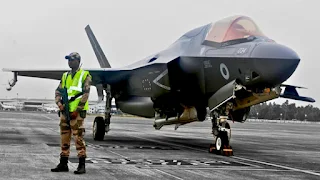On a humid Saturday night in Kerala, a supersonic whisper sliced through the skies. A British F-35 Lightning II, a symbol of cutting-edge stealth aviation, touched down at Thiruvananthapuram International Airport, citing "critically low fuel." What appeared at first as a routine emergency soon evolved into a diplomatic spectacle, technical enigma, and social media sensation.
✈️ A Jet, a Joke, and an Indian Welcome
Within hours of its unexpected
landing, the F-35 made an even more surprising appearance — not in a hangar,
but on OLX, India's go-to platform for second-hand goods. An anonymous
prankster uploaded a photograph of the jet, cheekily listing it for sale. It
was the kind of satire only India could pull off: transforming an international
defense incident into a viral meme.
It was hilarious, sure. But beneath
the humour lay questions of geopolitics, radar superiority, and military
diplomacy.
📡 The Radar Revelation: India Spots the
Invisible
Touted as a crown jewel of Lockheed
Martin, the F-35 is engineered to slip past radar defenses. Its stealth
design is meant to render it practically invisible. But not to India’s eyes
in the sky.
Indian Air Force sources indicated the
aircraft was detected before it declared an emergency. The British pilot
reportedly turned on the plane's transponders only after Indian radar locked on
to it.
Official accounts later claimed that
the F-35 was tracked because of its emergency signal — a narrative
perhaps more suited for maintaining polite diplomatic optics and protecting
Lockheed Martin’s reputation.
But observers know better. This was
not the first time stealth was undone by Indian radar.
🔧 F-35 Can't Fly: Fuel First, Then
"Technical Glitches"
Once safely on Indian soil, the F-35
was refuelled promptly. But oddly, it still couldn't fly. Why? Vague technical
problems. Despite Indian offers to shelter the aircraft from Kerala's heavy
monsoon rains and build temporary hangar protection, the British pilot refused
to move it.
Instead, the jet remained parked in an
open corner of the tarmac, with the lone pilot standing guard like a loyal
soldier shielding a secret.
"My toy is
in your house, but don’t touch it."
India, ever the gracious host,
complied — and quietly watched.
🎯 India's Silent Superpower: Radar and
Restraint
This isn’t India’s first encounter
with stealth aircraft. Last year, Indian radar reportedly detected Turkish Bayraktar
TB2 stealth drones during trials. The message is becoming clear: stealth
isn't so stealthy anymore in Indian airspace.
SU-57 and the
Radar Rift
Weeks before the F-35 landed, India
and Russia were close to signing a joint production deal for the SU-57,
Russia's fifth-generation stealth fighter. But negotiations soured.
India requested permission to fit its
indigenous AESA radar into the aircraft. Russia refused, arguing that
sharing radar codes and tech specs with Indian engineers would compromise their
platform's secrets.
Russia’s hesitation reflects a broader
concern: that India's radar capabilities are now strong enough to challenge
the myth of invincibility surrounding stealth tech.
🛰️ Tech Shift: From Buyer to Innovator
For decades, India has been known as a
defense importer. But now, with DRDO-led advances in multi-band, AI-driven
radar systems, the balance is shifting.
In an age where warfare is
increasingly about detection, India’s ability to unmask cloaked threats gives
it a unique edge. In fact, a 2024 RAND Corporation report warned:
"Stealth
technology was designed for the radar capabilities of the 1990s. Modern
detection systems using AI-assisted multi-static radars significantly reduce
their effectiveness." — RAND Corporation,
2024
India may not boast. But it detects.
And that quiet capability is turning heads.
🤝 Diplomacy Meets Defense: India the Gracious
Host
Despite being caught off-guard by a
radar-dodging fighter jet, India responded with poise.
No aggressive headlines. No
undiplomatic finger-pointing. Just fuel, hospitality, and a smile. Behind the
scenes, however, Indian agencies were undoubtedly scanning, logging, and
learning. As is the Indian way.
"Strategic
autonomy," after all, is
not about confrontation; it's about control without conflict.
India didn't expose Lockheed Martin.
It didn’t blame the UK. It didn’t demand answers. But it knows what happened.
And more importantly: so does the rest
of the world.
🤔 Between Satire and Strategy
Was the OLX listing a joke? Of course.
But like all good satire, it disguised
deeper truths. India is no longer a passive observer in global defense. It is a
quiet influencer. A radar-rich observer. And when stealth fails to hide from
India, it shakes more than just the pilot's pride.
The world laughed at the fake ad, but
India’s defense community nodded quietly, knowing:
"We saw it.
We tracked it. We helped. And we remembered everything."
By Pradeep Mahaur – Pradeep Mahaur Magazine
Insights on Hindu Wisdom and Global Affairs from an Indic perspective.
📚 References:
- RAND
Corporation 2024 Report on Stealth Vulnerability
- BBC News -
British F-35 lands in India
- Livefist Defence -
India’s AESA Radar Programs
- The
Print - Why India-Russia SU-57 Deal Faltered
- India.com
- Has India cracked the ‘stealth code’?
- OP
India- British Navy’s F-35 remains stranded
- Swarajya-
IAF's Air Defence Grid 'Detected' British F-35


Comments
Post a Comment
If you have any queries please let me know